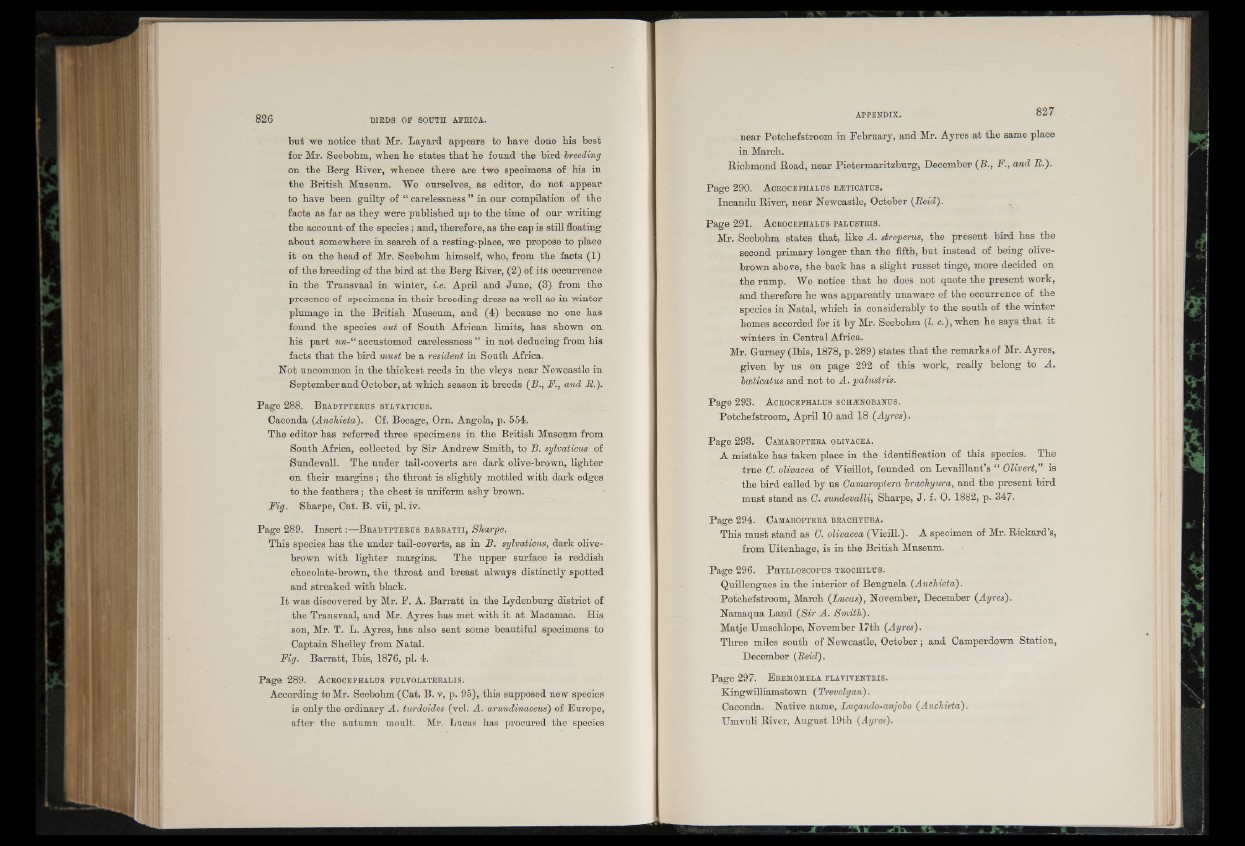
but we notice tha t Mr. Layard appears to have done his best
for Mr. Seebohm, when he states th a t he found the bird breeding
on the Berg River, whence there are two specimens of his in
the British Museum. We ourselves, as editor, do not appear
to have been guilty of “ carelessness ” in our compilation of the
facts as far as they were published up to the time of our writing
the account of the species; and, therefore, as the cap is still floating
about somewhere in search of a resting-place, we propose to place
it on the head of Mr. Seebohm himself, who, from the facts (1)
of the breeding of the bird at the Berg River, (2) of its occurrence
in the Transvaal in winter, i.e. April and June, (3) from the
presence of specimens in their breeding dress as well as in winter
plumage in the British Museum, and (4) because no one has
found the species out of South African limits, has shown on
his part un-“accustomed carelessness” in not deducing from his
facts that the bird must be a resident in South Africa.
Rot uncommon in the thickest reeds in the vleys near Newcastle in
September and October, at which season it breeds (B., F., and 22.).
Page 288. B r a d y p t e r u s s y lv a ti c u s .
Caconda {Anchieta'). Cf. Bocage, Om. Angola, p. 554.
The editor has referred three specimens in the British Museum from
South Africa, collected by Sir Andrew Smith, to B. sylvaticus of
Sundevall. The under tail-coverts are dark olive-brown, lighter
on their margins ; the throat is slightly mottled with dark edges
to the feathers ; the chest is uniform ashy brown.
Fig. Sharpe, Cat. B. vii, pi. iv.
Page 289. In s e rt:—B r a d y p t e r u s b a b r a t t i , Sharpe.
This species has the under tail-coverts, as in B. sylvaticus, dark olive-
brown with lighter margins. The upper surface is reddish
chocolate-brown, the throat and breast always distinctly spotted
and streaked with black.
I t was discovered by Mr. P. A. Barratt in the Lydenburg district of
the Transvaal, and Mr. Ayres has met with it a t Macamac. His
son, Mr. T. L. Ayres, has also sent some beautiful specimens to
Captain Shelley from Natal.
Fig. Barratt, Ibis, 1876, pi. 4.
Page 289. A c r o c e p h a lu s f u l v o l a t e r a l i s .
According to Mr. Seebohm (Cat. B. v, p. 95), this supposed new species
is only the ordinary A. turdoides (vel. A. a/rundinaceus) of Europe,
after the autumn moult. Mr. Lucas has procured the species
. near Potehefstroom in February, and Mr. Ayres at the same place
in March.
Richmond Road, near Pietermaritzburg, December (P., F., and 22.).
Page 290. A c r o c e p h a lu s b j i t i c a tu s .
Incandu River, near Newcastle, October (22eid).
Page 291. A c r o c e p h a lu s p a lu s t r i s .
Mr. Seebohm states that, like A. streperus, the present bird has the
second primary longer than the fifth, but instead of being olive-
brown above, the back has a slight russet tinge, more decided on
the rump. We notice th a t he does not quote the present work,
and therefore he was apparently unaware of the occurrence of the
species in Natal, which is considerably to the south of the winter
homes accorded for it by Mr. Seebohm {I. c.), when he says th a t it
winters in Central Africa.
Mr. Gurney (Ibis, 1878, p. 289) states th a t the remarks of Mr. Ayres,
given by us on page 292 of this work, really belong to A.
bceticatus and not to A. palustris.
Page 293. A c r o c e p h a lu s s c h jsn o b a n u s .
Potehefstroom, April 10 and 18 {Ayres).
Page 293. C am a ro p te r a o liv a c e a .
A mistake has taken place in the identification of this species. The
true G. olivacea of Vieillot, founded on Levaillant’s “ Olivert," is
the bird called by us Camaroptera brachyura, and the present bird
must stand as G. sundevalli, Sharpe, J . f. O. 1882, p. 347.
Page 294. C am a ro p te r a b r a c h y u r a .
This must stand as 0. olivacea (Vieill.). A specimen of Mr. Rickard’s,
from Uitenhage, is in the British Museum.
Page 296. P b y l lo s c o p u s t r o c h i l u s .
Quillengues in the interior of Benguela {Anchieta).
Potehefstroom, March (Lucas), November, December (Ayres).
Namaqua Land (Sir A. Smith).
Matje Umschlope, November 17th (Ayres).
Three miles south of Newcastle, October; and Camperdown Station,
December (Reid).
Page 297. E r em om e la f l a v i v e n t r i s .
Kingwilliamstown (Trevelyan).
Caconda. Native name, Lugando-anjobo (Anchieta).
Umvuli River, August 19th (Ayres).